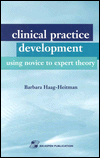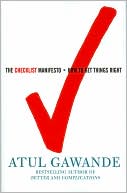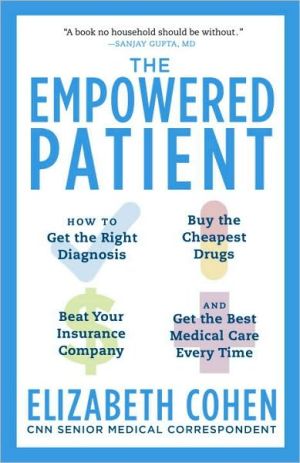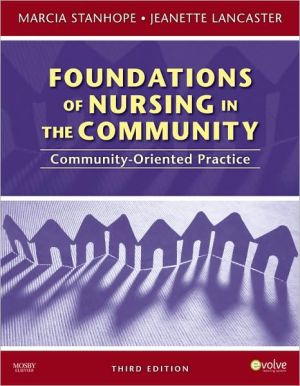Clinical Practice Development Using Novice to Expert Theory
Count on this guide to help you implement these proven "novice to expert" techniques! Get proven methods to creatively help staff nurses progress in their profession. Find out what it takes to clearly define nursing practice and nurture that role among nurses and other disciplines at a time when the healthcare environment is focused on downsizing, redefining roles, and ongoing quality improvement activities.\ Features -- With this novice-to-expert model, you can:\ \ Evaluate nurses on their...
Search in google:
This is the first book on novice to expert theory that is a guide to implementation. St. Luke's Medical Center, one of the first institutions in the country to successfully implement Novice to Expert, shows how they did it. This book can be used as a practical guide by any patient care executive interested in finding out more about novice to expert. This book explains the theoretical components of novice to expert, how to design and apply a model, how to implement that model, and what problems and results to expect. Unique - The only novice-to-expert book focused on practice. Mary Ellen Wurzbach This is a description of the development of a clinical practice model at St. Luke's Medical Center in Milwaukee, Wisconsin using Banner's novice-to-expert theory. The editor explains how the model was initiated and extended to a regional Aurora Health Care System approach for both nursing practice and nursing research. The purpose is to describe the organizational journey in the implementation of a staff nurse peer review and advancement model based on a novice-to-expert framework that is grounded in narrative methodology. This is a worthy objective and it is met admirably, The editor does not indicate the anticipated audience for the book, but I believe it would be most helpful for nursing administrators who wish to implement a positive practice environment. It may also serve as a practical guide for staff nurses making the practice change. This is a very clearly written description of the development of a novice-to-expert nursing practice model that emphasizes clinical judgment, caring, and collaboration. Based upon Patricia Banner's theory, narratives of staff members are interpreted by a panel of peer experts to identify domains of practice and the characteristics of these domains. The model, and its extension to encompass a regional healthcare system for both clinical practice and clinical research, are detailed. Journal articles exist that describe this approach to nursing practice, but this is the first book-length treatment of this subject. Banners' philosophy for improving nursing practice in Chapter 2 is particularly eloquent. St. Luke's Medical Center changed from a career ladder approach to a narrative based novice-to-expert approach. In this book, the development ofthis change is described, beginning with the philosophical underpinnings explained particularly well by Patricia Banner, their consultant. The unique feature is the step-by-step approach to the project.
ContributorsxiForewordxvAcknowledgmentsxixIntroductionxxiChapter 1Vision to Reality: A Historical Perspective1From Career Ladder to a Clinical Development Model2Reflecting on the Past2The Peer Review Process7A Language Needed for Practice8The Effects of Culture on Care9Doing Versus Being10Shifting the Paradigm: Implementation of a New Governance Model11Next Steps16Chapter 2The Clinical Practice Development Model: Making the Clinical Judgment, Caring, and Collaborative Work of Nurses Visible17Using Clinical Narratives to Reflect on Practice--Growing and Extending Excellent Practice31Reading and Reflecting on Narratives35The Distinctions, Dis-junctures, and Risks in Using Narratives as Research Data and Using Narratives as Evaluation Tools39References41Chapter 3Developing the Clinical Practice Development Model at St. Luke's Medical Center43The Emergence of a New Model43Getting Started44Narrative Workgroup Selection45Consultation Support47First Steps in Design47Development of Practice Domains48First Communications with the Entire Nursing Body52Next Steps53Validation53Creating an Understanding of the New Model53Promoting Leadership Proficiency64Implementation64Chapter 4Use of a Steering Committee to Guide Implementation65Decision to Use Narratives to Measure Practice68Separating Clinical Advancement from Annual Review69CPDM Implementation Workgroup70Learning About the Concerns of Staff72Developing New Understanding74Champions for Change76Model Education77Transition Celebration80Completion of Transition82Evaluating the Process83Summarizing the Transition84Suggested Reading85Chapter 5Determining Staff Nurses' Developmental Stages Using a Peer Review Process87A Historical Look at Peer Review88Structuring the Process at St. Luke's91First Panel Members92Validation Process93Creation of House-Wide and Unit-Based Panels102Panel Facilitator Role102Coordination of the Paneling Process107Panel Narrative Packet108Applicant's Interview111Applicant and Panel Members' Responses113Supporting Panel Members114References116Chapter 6Coaching: An Integral Component117Learning Relationships117Leadership's Role119Enhancing Professional Growth through Focused Practice Dialogue120Learning the Coaching Role122Coaching Guidelines127Essential Elements130Fostering Professional Development and Lifelong Learning133References135Chapter 7Staff Nurses' Experiences During Transition and Beyond137Study Purpose and Methodology139Results of the Study144Summary and Recommendations150References151Suggested Readings151Chapter 8The Manager's Experience153Management Council Accountabilities153Removing System Barriers to Practice160Posttransition: Using Knowledge of Staff's Developmental Stages to Achieve Organizational Goals161A Practical Approach to Achieving Desired Outcomes162Summary163Reference164Chapter 9Moving Beyond Transition: Enhancing the Process Through Performance Improvement Activities165Transition Process Enhancements167The Starting Point: Applicant Accountabilities168Monitoring the Quality of the Peer Review Panel Process168Monitoring Panel Outcomes171Appeals171Panel of Nonconsensus172Ongoing Monitoring of the Process173Chapter 10Metro Clinical Practice Development Model: Redesign for the Region175History176The Design Team178Design Team Charter179Clinical Focus Determined180Benner's Novice to Expert Model is Chosen184Creating the Metro Clinical Practice Development Model (MCPDM)188Implementation192Chapter 11Future Trends: Advancing Professional Practice in an Interdisciplinary Model195Interdisciplinary professional Practice Model197Interdisciplinary Collaborative Governance Structure200Professional Development Committee203Articulating Themes of Practice through Clinical Narratives204Review Process for Themes of Practice206Clinical Narratives as Tools to Enhance Professional Development213Continuing Steps213Summary215References215Chapter 12Defining the Essence of Health Care Practice through Novice to Expert Models: Research-Basis and Future Opportunities217Are Novice to Expert Models Valid and Reliable?218Internal Validity, Credibility, and Authenticity218External Validity, Transferability, and Fittingness220Reliability, Dependability, and Audibility221Summary of Validity and Reliability Issues225Future Directions for Research225Conclusion226References227Chapter 13.The Role of the Chief Nurse Executive in Fostering Excellence in the Professional Practice Environment229A New Context for Organizations229The Role of the Chief Nurse Executive230The Role of the Professional Nurse231The Role of Professionals in Organizations232Nursing as a Profession234Nursing Shared Governance235Peer Review and Professional Practice236Building for Excellence in Patient Care238References239Appendix AFrom Career Ladder to Clinical Practice Development Model (CPDM): A Timeline at a Glance241Appendix BProfessional Nursing Assembly Diagram and Bylaws245Appendix CClinical Practice Development Model253Appendix DStaging/Advancement Policy for the Clinical Practice Development Model263Appendix ECPDM Applicant Feedback Form275Appendix FCPDM Coach Feedback Form279Index281About the Contributors291
\ From The CriticsReviewer: Mary Ellen Wurzbach, RN, MSN, PhD(University of Wisconsin-Oshkosh)\ Description: This is a description of the development of a clinical practice model at St. Luke's Medical Center in Milwaukee, Wisconsin using Banner's novice-to-expert theory. The editor explains how the model was initiated and extended to a regional Aurora Health Care System approach for both nursing practice and nursing research.\ Purpose: The purpose is to describe the organizational journey in the implementation of a staff nurse peer review and advancement model based on a novice-to-expert framework that is grounded in narrative methodology. This is a worthy objective and it is met admirably,\ Audience: The editor does not indicate the anticipated audience for the book, but I believe it would be most helpful for nursing administrators who wish to implement a positive practice environment. It may also serve as a practical guide for staff nurses making the practice change.\ Features: This is a very clearly written description of the development of a novice-to-expert nursing practice model that emphasizes clinical judgment, caring, and collaboration. Based upon Patricia Banner's theory, narratives of staff members are interpreted by a panel of peer experts to identify domains of practice and the characteristics of these domains. The model, and its extension to encompass a regional healthcare system for both clinical practice and clinical research, are detailed. Journal articles exist that describe this approach to nursing practice, but this is the first book-length treatment of this subject. Banners' philosophy for improving nursing practice in Chapter 2 is particularly eloquent. \ Assessment: St. Luke's Medical Center changed from a career ladder approach to a narrative based novice-to-expert approach. In this book, the development of this change is described, beginning with the philosophical underpinnings explained particularly well by Patricia Banner, their consultant. The unique feature is the step-by-step approach to the project.\ \ \ \ \ Mary Ellen WurzbachThis is a description of the development of a clinical practice model at St. Luke's Medical Center in Milwaukee, Wisconsin using Banner's novice-to-expert theory. The editor explains how the model was initiated and extended to a regional Aurora Health Care System approach for both nursing practice and nursing research. The purpose is to describe the organizational journey in the implementation of a staff nurse peer review and advancement model based on a novice-to-expert framework that is grounded in narrative methodology. This is a worthy objective and it is met admirably, The editor does not indicate the anticipated audience for the book, but I believe it would be most helpful for nursing administrators who wish to implement a positive practice environment. It may also serve as a practical guide for staff nurses making the practice change. This is a very clearly written description of the development of a novice-to-expert nursing practice model that emphasizes clinical judgment, caring, and collaboration. Based upon Patricia Banner's theory, narratives of staff members are interpreted by a panel of peer experts to identify domains of practice and the characteristics of these domains. The model, and its extension to encompass a regional healthcare system for both clinical practice and clinical research, are detailed. Journal articles exist that describe this approach to nursing practice, but this is the first book-length treatment of this subject. Banners' philosophy for improving nursing practice in Chapter 2 is particularly eloquent. St. Luke's Medical Center changed from a career ladder approach to a narrative based novice-to-expert approach. In this book, the development ofthis change is described, beginning with the philosophical underpinnings explained particularly well by Patricia Banner, their consultant. The unique feature is the step-by-step approach to the project.\ \ \ BooknewsSeveral nursing experts join Haag-Heitman, a clinical nurse specialist at St. Luke's Medical Center, Milwaukee, Wisconsin where the Clinical Practice Development Model evolved. The model incorporates a novice-to-expert approach which identifies how nurses develop skills and expertise, and how the work setting can acknowledge, reflect, and foster the central role of nurses in health care. The contributors explore the creation of the model and its implementation, with discussion of the peer review process, coaching, the experiences of staff nurses and of managers, performance improvement activities, and the role of the chief nurse executive. Annotation c. Book News, Inc., Portland, OR (booknews.com)\ \ \ \ \ 3 Stars from Doody\ \








